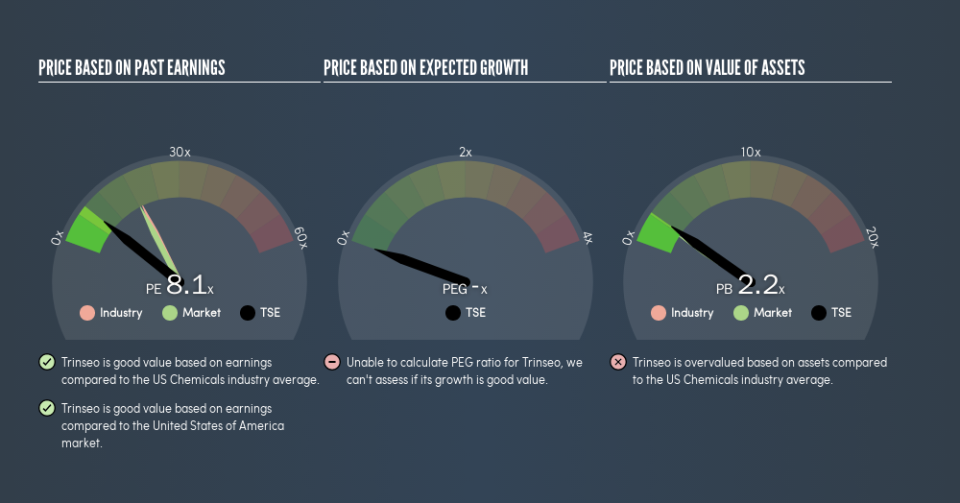Read This Before You Buy Trinseo S.A. (NYSE:TSE) Because Of Its P/E Ratio

Want to participate in a short research study? Help shape the future of investing tools and you could win a $250 gift card!
The goal of this article is to teach you how to use price to earnings ratios (P/E ratios). To keep it practical, we'll show how Trinseo S.A.'s (NYSE:TSE) P/E ratio could help you assess the value on offer. What is Trinseo's P/E ratio? Well, based on the last twelve months it is 8.09. In other words, at today's prices, investors are paying $8.09 for every $1 in prior year profit.
Check out our latest analysis for Trinseo
How Do I Calculate A Price To Earnings Ratio?
The formula for P/E is:
Price to Earnings Ratio = Share Price ÷ Earnings per Share (EPS)
Or for Trinseo:
P/E of 8.09 = $39.79 ÷ $4.92 (Based on the year to March 2019.)
Is A High P/E Ratio Good?
A higher P/E ratio means that buyers have to pay a higher price for each $1 the company has earned over the last year. That is not a good or a bad thing per se, but a high P/E does imply buyers are optimistic about the future.
How Growth Rates Impact P/E Ratios
P/E ratios primarily reflect market expectations around earnings growth rates. When earnings grow, the 'E' increases, over time. Therefore, even if you pay a high multiple of earnings now, that multiple will become lower in the future. And as that P/E ratio drops, the company will look cheap, unless its share price increases.
Trinseo shrunk earnings per share by 35% over the last year. But it has grown its earnings per share by 109% per year over the last five years.
How Does Trinseo's P/E Ratio Compare To Its Peers?
We can get an indication of market expectations by looking at the P/E ratio. The image below shows that Trinseo has a lower P/E than the average (18.8) P/E for companies in the chemicals industry.
Its relatively low P/E ratio indicates that Trinseo shareholders think it will struggle to do as well as other companies in its industry classification. Many investors like to buy stocks when the market is pessimistic about their prospects. It is arguably worth checking if insiders are buying shares, because that might imply they believe the stock is undervalued.
A Limitation: P/E Ratios Ignore Debt and Cash In The Bank
The 'Price' in P/E reflects the market capitalization of the company. That means it doesn't take debt or cash into account. Theoretically, a business can improve its earnings (and produce a lower P/E in the future) by investing in growth. That means taking on debt (or spending its cash).
Spending on growth might be good or bad a few years later, but the point is that the P/E ratio does not account for the option (or lack thereof).
How Does Trinseo's Debt Impact Its P/E Ratio?
Trinseo's net debt equates to 40% of its market capitalization. You'd want to be aware of this fact, but it doesn't bother us.
The Bottom Line On Trinseo's P/E Ratio
Trinseo has a P/E of 8.1. That's below the average in the US market, which is 18.2. The debt levels are not a major concern, but the lack of EPS growth is likely weighing on sentiment.
Investors should be looking to buy stocks that the market is wrong about. If the reality for a company is not as bad as the P/E ratio indicates, then the share price should increase as the market realizes this. So this free visual report on analyst forecasts could hold the key to an excellent investment decision.
But note: Trinseo may not be the best stock to buy. So take a peek at this free list of interesting companies with strong recent earnings growth (and a P/E ratio below 20).
We aim to bring you long-term focused research analysis driven by fundamental data. Note that our analysis may not factor in the latest price-sensitive company announcements or qualitative material.
If you spot an error that warrants correction, please contact the editor at editorial-team@simplywallst.com. This article by Simply Wall St is general in nature. It does not constitute a recommendation to buy or sell any stock, and does not take account of your objectives, or your financial situation. Simply Wall St has no position in the stocks mentioned. Thank you for reading.

